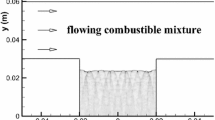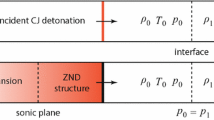Abstract
We present two-dimensional numerical simulations of the transmission of detonation from a rectangular channel into a larger volume. The simulations solve the Euler equations on a Cartesian grid using the method of Flux-Corrected Transport for the fluid equations and a two-step induction parameter model for the chemistry. We simulate detonation in a H2/O2/Ar mixture and use sufficient grid resolution to resolve the cellular structure of the detonation. When a planar detonation front without a resolved cellular structure expands into the larger volume, the reaction front separates from the shock front and the detonation fails. When the planar front is perturbed to induce a quasi-regular cellular structure in the detonation, it again initially begins to fail, but now the presence of the transverse waves leads to reignition of the detonation in the larger volume. The form of this reignition shows striking similarities to the reignition of detonation which has been seen experimentally in H2/O2 mixtures. We describe this reignition mechanism in detail, and also investigate the dependence of the reignition on the number of cells in the detonation front.
Similar content being viewed by others
References
Dabora EK, Desbordes D, Guerraud C and Wagner HG (1991) Oblique Detonation at Hypersonic Velocities. Progress in Astronautics and Aeronautics 133: 187–201
Guirao CM, Knystautas R and Lee JH (1989) A Summary of Hydrogen-Air Detonation Experiments, Rept. NUREG/CR-4961, Prepared for Nuclear Regulatory Commission at McGill University, May 1989
Guirguis R, Oran ES, Kailasanath K (1986) Numerical Simulations of the Cellular Structure of Detonations in Liquid Nitromethane—Regularity of the Cell Structure. Combustion and Flame 65: 339–366
Jones DA, Sichel M, Oran ES, Guirguis R (1990) Detonation Transmission in Layered Explosives. Proceedings of the 23rd Symposium (International) on Combustion, The Combustion Institute, Pittsburgh, pp. 1805–1811
Jones DA, Sichel M, Guirguis R, Oran ES (1991) Numerical Simulation of Layered Detonations. Progress in Astronautics and Aeronautics 133: 202–219
Jones DA, Sichel M, Oran ES (1995) Reignition of Detonation by Reflected Shocks. Shock Waves 5: 47–57
Kailasanath K, Oran ES, Boris JP, Young TR (1985) Determination of Detonation Cell Size and the Role of Transverse Waves in Two-Dimensional Detonations. Combust. Flame 61: 199–209
Liou JJ (1986) Analysis of the Wave Interaction Between a Propagating Gaseous Detonation and a Bounding Explosive Layer. PhD thesis, The University of Michigan
Liu JC, Liou JJ, Sichel M, Kauffman CW, Nicholls JA (1987) Diffraction and Transmission of a Detonation into a Bounding Explosive Layer. Proceedings of the 21st Symposium (International) on Combustion, The Combustion Institute, Pittsburgh pp. 1659–1668
Liu JC, Sichel M, Kauffman CW (1988) The Lateral Interaction of Detonating and Detonable Gas Mixtures. Progress in Astronautics and Aeronautics 114: 264–283
Oran ES and Boris JP (1987) Numerical Simulation of Reactive Flow, Elsevier Science Publishing Co. Inc.
Oran ES, Boris JP, Jones DA, Sichel M (1993) Ignition in a Complex Mach Structure. Progress in Astronautics and Aeronautics 153: 241–252
Oran ES, Boris, JP, Young, TR, Picone JM (1981) Numerical simulations of detonations in hydrogen-air and methane-air mixtures. Proceedings of the Eighteenth Symposium (International) on Combustion, pp. 1641–1649, The Combustion Institute Pittsburgh, PA
Oran ES, Jones DA, Sichel M (1992) Numerical Simulations of Detonation Transmission. Proc. R. Soc. Lond. A 436: 267–297
Sichel M (1992) Transition to Detonation—Role of Explosion within an Explosion. In: Hussaini MY, Kumar A and Voight RG (eds.) Major Research Topics in Combustion, Springer-Verlag, pp 491–524
Strehlow RA (1984) Combustion Fundamentals, pp. 307, McGraw Hill, New York
Tonello NA, Sichel M, Oran ES (1995) A Simplified Kinetic Model for Detonations in H2−O2, presented at the 15th International Colloquium on the Dynamics of Explosions and Reactive Systems, Boulder, CO, August, 1995
Author information
Authors and Affiliations
Rights and permissions
About this article
Cite this article
Jones, D.A., Kemister, G., Oran, E.S. et al. The influence of cellular structure on detonation transmission. Shock Waves 6, 119–129 (1996). https://doi.org/10.1007/BF02510992
Received:
Accepted:
Issue Date:
DOI: https://doi.org/10.1007/BF02510992




